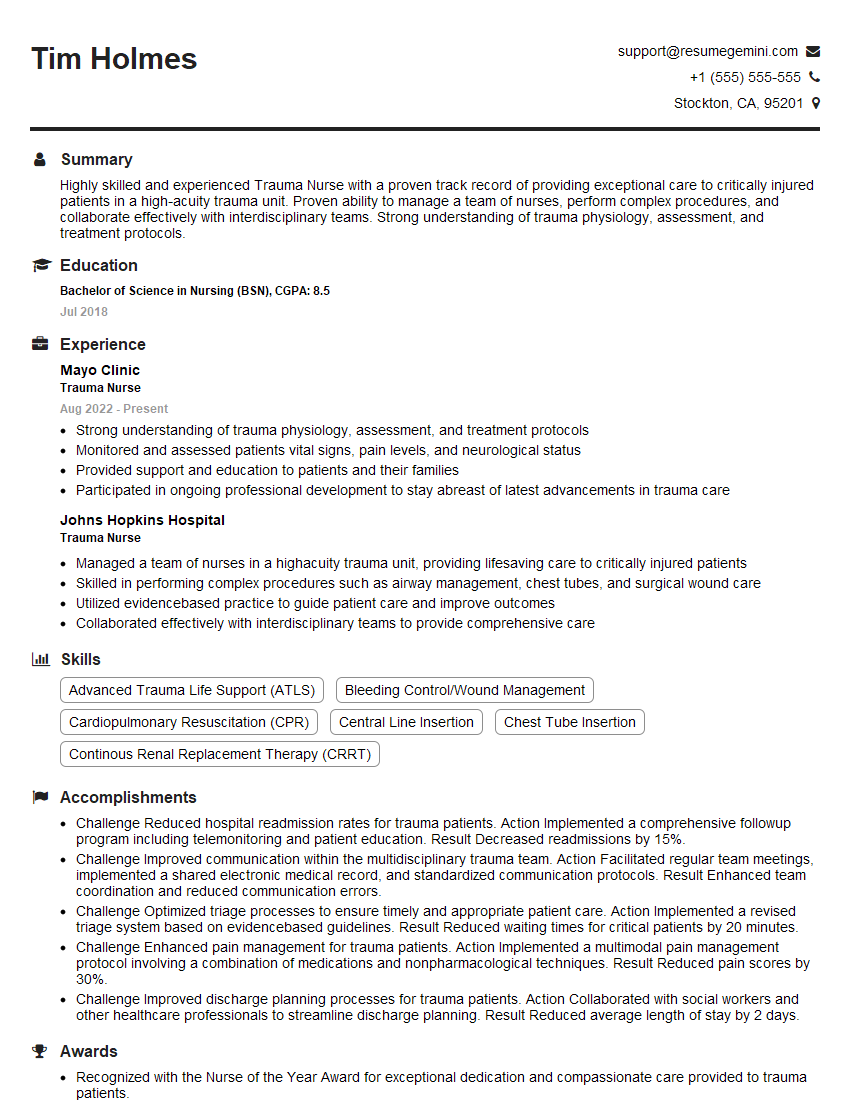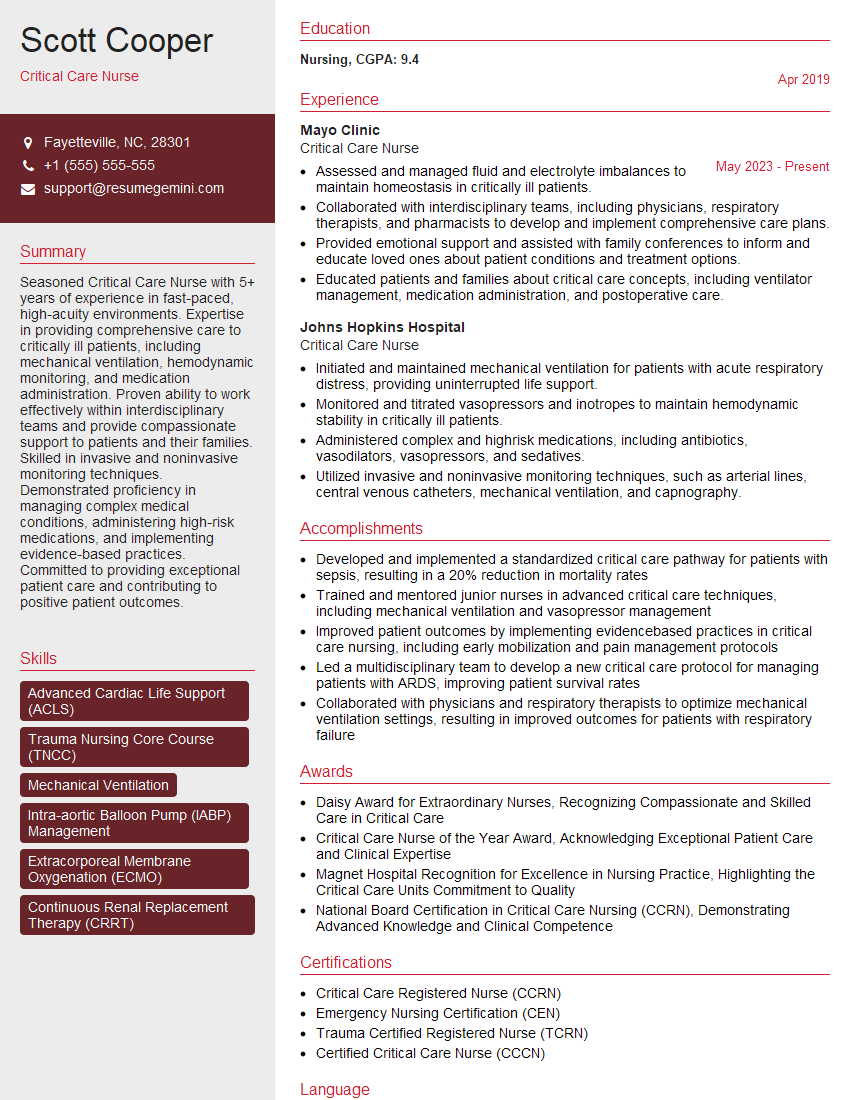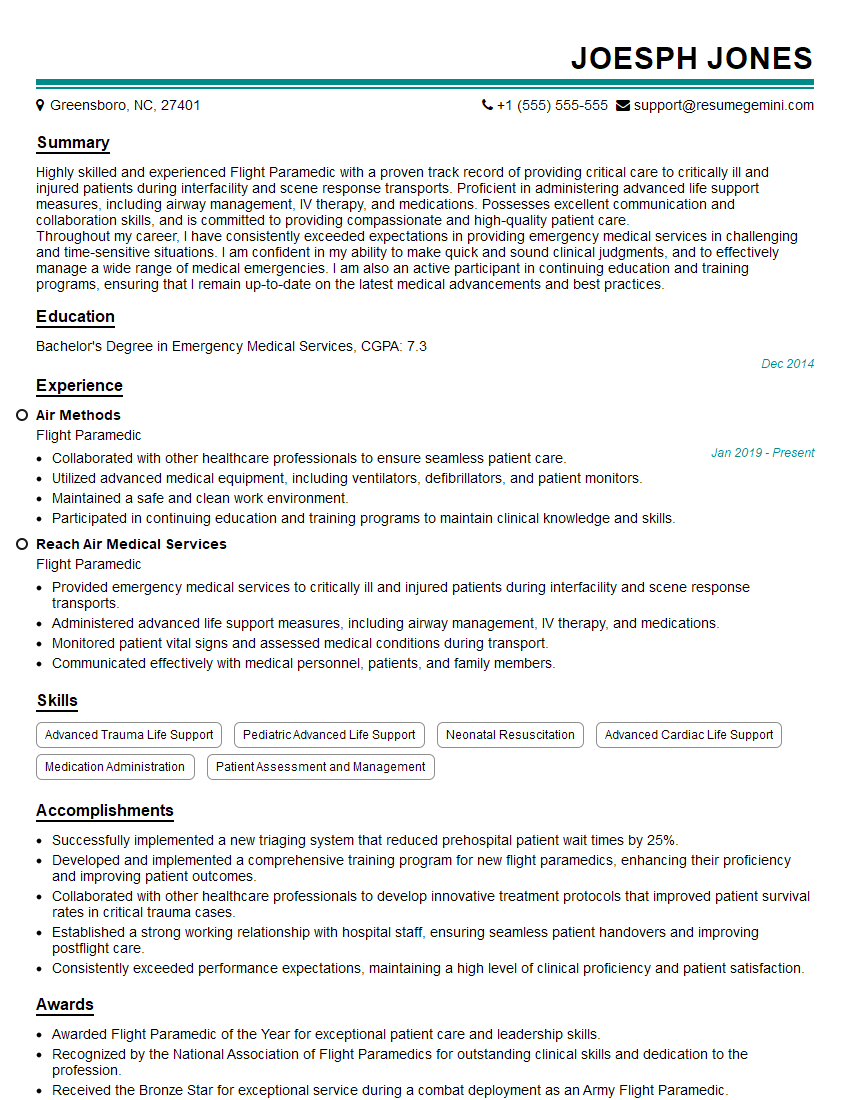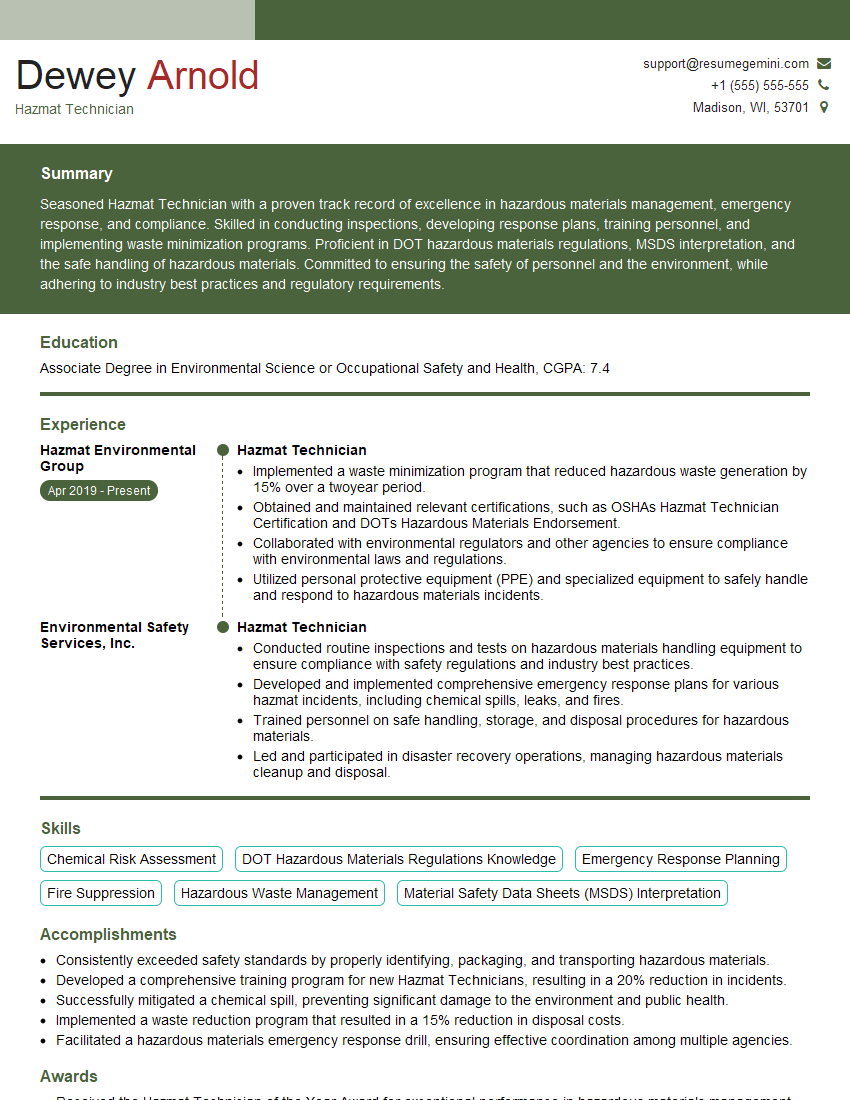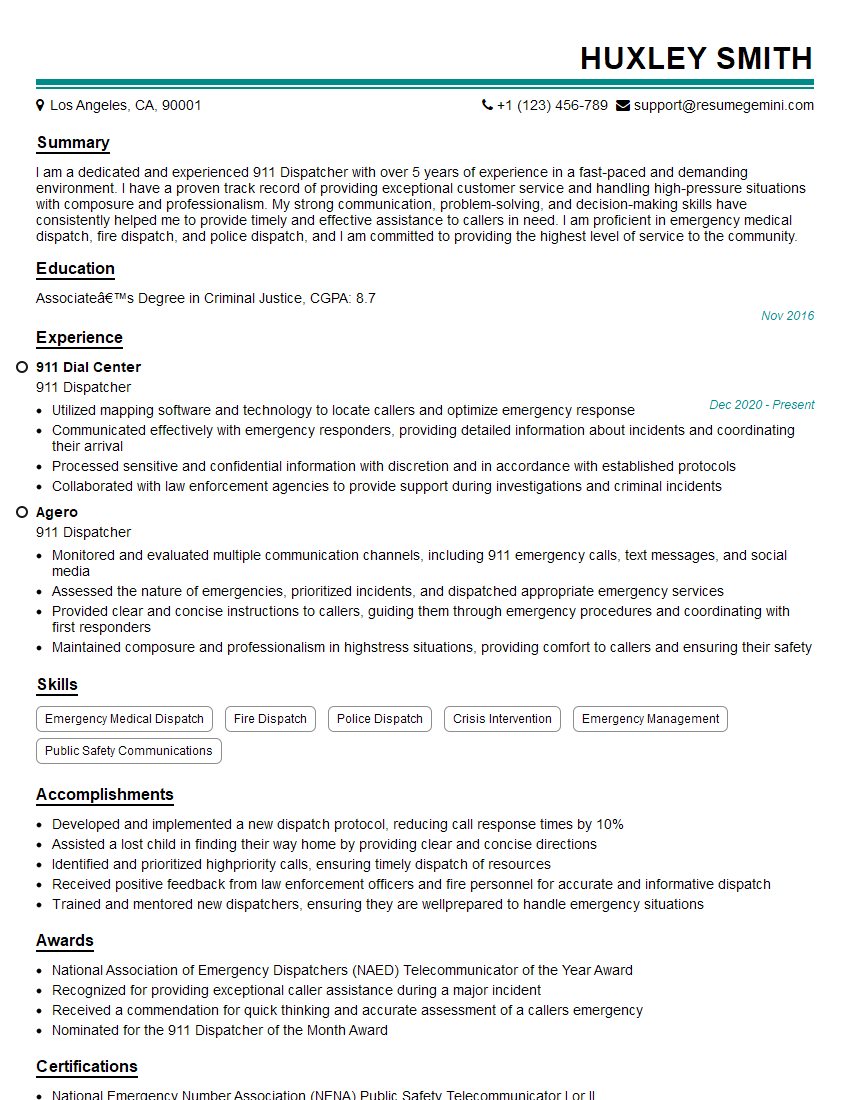Warning: search_filter(): Argument #2 ($wp_query) must be passed by reference, value given in /home/u951807797/domains/techskills.interviewgemini.com/public_html/wp-includes/class-wp-hook.php on line 324
Every successful interview starts with knowing what to expect. In this blog, we’ll take you through the top Handling Emergencies interview questions, breaking them down with expert tips to help you deliver impactful answers. Step into your next interview fully prepared and ready to succeed.
Questions Asked in Handling Emergencies Interview
Q 1. Describe your experience in prioritizing tasks during a high-pressure emergency situation.
Prioritizing tasks during a high-pressure emergency hinges on a systematic approach. I utilize a method I call the ‘Triaging Triangle,’ which combines urgency, impact, and resources. First, I identify tasks based on their urgency – those immediately threatening life or property come first. Next, I assess the impact of each task on the overall situation. A task with significant potential for widespread negative consequences gets higher priority. Finally, I consider the resources needed – personnel, equipment, time. A task requiring minimal resources yet having high urgency and impact takes precedence.
For example, in a building fire, rescuing trapped individuals is paramount (high urgency, high impact). Simultaneously, directing firefighters to control the fire’s spread is critical (high urgency, high impact). While securing the building’s perimeter is important (moderate urgency, moderate impact), it might be delegated until the immediate life-threatening situations are addressed. The Triaging Triangle ensures a logical sequence that maximizes efficiency and positive outcomes under extreme time pressure.
Q 2. How do you assess the severity of an emergency situation?
Assessing emergency severity involves a multi-faceted approach that considers several factors. I use a framework called ‘SITUATION,’ which stands for Severity, Immediacy, Type, Urgency, Area, Time, and Resources. Severity refers to the potential for harm – loss of life, injuries, property damage. Immediacy considers how quickly the situation is deteriorating. Type categorizes the incident (fire, flood, medical emergency). Urgency is the speed at which action is required. Area indicates the geographical scope of the emergency. Time refers to when the event occurred and the elapsed time since. Finally, Resources considers the available personnel, equipment, and support needed for effective response.
For instance, a small kitchen fire (low severity) contained in one room is different from a large wildfire (high severity) consuming multiple buildings. SITUATION ensures a holistic assessment before determining the appropriate response.
Q 3. What methods do you use to communicate effectively during an emergency?
Effective communication during an emergency is vital. I employ a tiered system combining clear, concise verbal communication with technology-aided methods. For immediate, critical information, I use simple, direct language avoiding jargon. I repeat key messages to ensure understanding. For example, instead of saying “We need to evacuate the building immediately due to the imminent structural collapse,” I’d say “Get out of the building now! The building is unsafe!” For coordinating larger-scale responses, I utilize a multi-channel communication strategy, including radio systems, mobile phones, and pre-established communication protocols. Clear channels and roles are essential to avoid confusion. Regular briefings ensure teams are informed and working toward the same objectives. Post-incident debriefings analyze communication successes and areas for improvement.
Q 4. Explain your approach to coordinating resources in an emergency.
Coordinating resources during an emergency requires a structured approach that balances speed and efficiency. I use a resource allocation matrix that maps available resources (personnel, equipment, supplies) to prioritized tasks. This matrix visualizes resource needs versus availability, identifying gaps and facilitating efficient deployment. I establish clear roles and responsibilities within incident command system structures (ICS), ensuring each team member understands their task and how it integrates into the overall strategy. Regular check-ins and status updates keep me aware of resource utilization and any emerging needs, allowing me to dynamically adjust the allocation as needed. Real-time monitoring and feedback loops are crucial for adapting to changing circumstances and optimizing resource efficiency.
Q 5. How do you maintain composure and decision-making abilities under stress?
Maintaining composure under stress is a skill honed over years of experience. I use techniques like deep breathing exercises to manage physiological responses to stress. Mentally, I focus on the task at hand, breaking down complex situations into manageable steps. Prioritizing tasks according to the Triaging Triangle framework provides a sense of control and direction. Maintaining open communication with my team fosters a sense of collaboration and shared responsibility, reducing individual pressure. Regular training and drills simulating high-pressure scenarios build resilience and confidence in my ability to handle unexpected situations.
Thinking ahead also helps. Pre-planning and having established protocols reduce uncertainty in the moment and prevent impulsive decisions. I regularly review and update these protocols. This proactive approach allows me to focus on immediate tasks without getting overwhelmed.
Q 6. Describe a time you had to make a quick, critical decision in an emergency.
During a severe blizzard, a large section of a highway became impassable due to snow drifts. Many vehicles were stranded, some with occupants suffering from hypothermia. I had to quickly decide whether to prioritize clearing the entire highway segment immediately or to focus on reaching the most vulnerable individuals first. Given the extreme weather conditions and limited resources, I decided to prioritize rescuing the hypothermic individuals. This involved dispatching specialized emergency vehicles equipped with rescue equipment and medical personnel to the most critical locations first, while coordinating with snow removal crews to establish safe access routes to these locations. While this meant a slower overall highway clearing process, it prioritized lives saved. The decision, while difficult, minimized harm and resulted in successful rescue operations.
Q 7. What are your strategies for preventing emergencies?
Preventing emergencies involves a proactive, multi-layered approach. This includes risk assessments to identify potential hazards and vulnerabilities, coupled with the development and implementation of comprehensive risk mitigation plans. Regular safety inspections, training programs, and drills help enhance preparedness. Establishing effective communication channels, both internal and external, ensures prompt response to any identified threats. Fostering a strong safety culture within any organization—encouraging reporting of potential hazards and regular safety discussions—is critical. Proactive maintenance of equipment, systems, and infrastructure minimizes failures that could trigger emergencies. Finally, strong community engagement can help foster a culture of preparedness and promote early warnings of potential crises.
Q 8. How familiar are you with emergency response protocols and procedures?
My familiarity with emergency response protocols and procedures is extensive. I’ve spent years working in high-pressure environments, developing a deep understanding of various emergency response frameworks, including those based on the Incident Command System (ICS) and National Incident Management System (NIMS). This includes understanding roles, responsibilities, communication strategies, and the importance of following established procedures to ensure efficiency and safety.
For instance, I’ve participated in numerous emergency drills and real-world incidents ranging from smaller-scale events like building fires to large-scale disasters involving mass casualties. Through these experiences, I’ve internalized the importance of rapid assessment, prioritization of tasks, and clear communication in a chaotic environment. My knowledge encompasses a wide array of emergencies, including natural disasters (hurricanes, earthquakes, floods), industrial accidents, and acts of terrorism.
Q 9. How do you delegate tasks effectively during an emergency?
Effective delegation during an emergency is critical for success. It’s not just about assigning tasks, but about assigning them to the right people with the right skills and ensuring clear communication of expectations. I utilize a structured approach, often mirroring the principles of ICS. First, I assess the situation and identify the key tasks needed to address the immediate threats and stabilize the situation. Then, I consider the skills and experience of my team members and delegate tasks accordingly. I always prioritize clear communication, providing individuals with specific instructions, expected outcomes, and reporting procedures.
For example, in a building fire, I might delegate one person to lead evacuation efforts, another to manage communication with emergency services, and another to coordinate the search and rescue of any trapped individuals. Regular check-ins and reassessments are essential to ensure tasks are completed effectively and adjustments can be made if needed.
Q 10. Describe your experience using emergency communication systems.
My experience with emergency communication systems is comprehensive. I’m proficient in using a variety of systems, including two-way radios, satellite phones, emergency alert systems (like mass notification systems), and various software platforms designed for incident management. I understand the importance of choosing the right communication system for the specific emergency and its scale. For instance, two-way radios are great for immediate, localized communication within a team, while satellite phones can be crucial in situations where cellular service is unavailable.
I’ve utilized these systems in various settings, from coordinating search and rescue operations in remote areas to managing communication during a large-scale chemical spill. The key is always maintaining clear and consistent communication, minimizing ambiguity, and ensuring that information flows effectively up, down, and across the chain of command. I also understand the critical importance of maintaining communication logs and records for post-incident analysis.
Q 11. How do you handle conflicting information or priorities during an emergency?
Handling conflicting information or priorities during an emergency requires a calm, methodical approach. The first step is to verify the information. This involves cross-referencing data from multiple sources and assessing the credibility of each source. Then, I prioritize information based on its impact on safety and immediate needs. A framework like the START triage system (Simple Triage and Rapid Treatment) can be very helpful in mass casualty situations.
For example, if I receive conflicting reports on the number of casualties during a natural disaster, I would prioritize verifying the information through multiple channels (police, fire, hospital reports). Once verified information is available, I can then create an appropriate plan, even if it involves making difficult choices about resource allocation based on the most pressing needs.
Q 12. What is your experience with risk assessment and mitigation?
Risk assessment and mitigation are integral parts of my emergency preparedness strategy. I’m skilled in conducting thorough risk assessments, identifying potential hazards, analyzing their likelihood and potential impact, and developing mitigation strategies to reduce the risk. This involves evaluating both the physical environment and the human factors that can contribute to emergencies.
For instance, before a large public event, I might conduct a risk assessment considering factors such as crowd size, potential weather conditions, access to medical facilities, and the presence of potential hazards. Based on this assessment, I would develop a mitigation plan that includes strategies like crowd control measures, emergency evacuation routes, and the deployment of first aid personnel. Regular reviews and updates of this assessment and plan are crucial.
Q 13. How do you debrief after an emergency incident?
A thorough debrief after an emergency incident is crucial for learning and improvement. Our debriefs typically follow a structured format, involving all team members involved in the response. The process focuses on both what went well and what could be improved. We use a non-judgmental approach to encourage open and honest feedback. The goals of the debrief include identifying areas for improvement in protocols, communication, resource allocation, and individual performance.
Key aspects of our debrief include a chronological review of the event, an analysis of decision-making processes, and a discussion of any challenges faced. The outcome is a documented report, outlining key findings, recommendations for improvement, and an action plan to implement changes. This continuous learning cycle helps us refine our emergency response procedures and enhance our overall preparedness.
Q 14. How do you ensure the safety of yourself and others during an emergency?
Ensuring the safety of myself and others is my top priority. This starts with following established safety protocols and procedures. Before entering any hazardous area, I conduct a thorough risk assessment and utilize appropriate personal protective equipment (PPE). I continuously monitor the situation, adapting my actions as needed. I stay informed on the developing situation and communicate clearly with my team and relevant authorities.
Beyond personal safety, I always prioritize the safety of others. In an evacuation scenario, I would ensure clear directions, assist those needing help, and maintain order to facilitate a safe and efficient evacuation. The principles of risk assessment and mitigation extend to the entire team and the wider population we are responsible for protecting. Ongoing training and adherence to best practices are crucial to maintaining this safety-first approach.
Q 15. What types of emergencies have you handled in the past?
Throughout my career, I’ve been involved in a wide range of emergencies. This includes natural disasters like hurricanes and floods, where I coordinated rescue efforts and managed resource allocation. I’ve also handled large-scale industrial accidents, requiring immediate responses to contain hazardous materials and ensure public safety. My experience also encompasses smaller-scale incidents such as building fires, medical emergencies, and active shooter situations, each demanding a unique approach and rapid decision-making.
- Hurricane Response: During Hurricane Katrina, I was part of a team that established temporary shelters, distributed essential supplies, and coordinated medical assistance for thousands of displaced individuals. This involved intricate logistical planning and working under extreme pressure.
- Industrial Accident: I led the response to a chemical spill at a manufacturing plant, ensuring the evacuation of personnel, containment of the spill, and collaboration with environmental agencies for cleanup and remediation.
Career Expert Tips:
- Ace those interviews! Prepare effectively by reviewing the Top 50 Most Common Interview Questions on ResumeGemini.
- Navigate your job search with confidence! Explore a wide range of Career Tips on ResumeGemini. Learn about common challenges and recommendations to overcome them.
- Craft the perfect resume! Master the Art of Resume Writing with ResumeGemini’s guide. Showcase your unique qualifications and achievements effectively.
- Don’t miss out on holiday savings! Build your dream resume with ResumeGemini’s ATS optimized templates.
Q 16. Describe your experience with emergency planning and preparedness.
Emergency planning and preparedness is the foundation of effective emergency response. My experience encompasses developing comprehensive emergency plans that include risk assessment, resource identification, communication protocols, and detailed response strategies. I’m proficient in conducting tabletop exercises and drills to test these plans, identify weaknesses, and refine procedures. A key aspect of my work is fostering a culture of preparedness within organizations, ensuring everyone understands their roles and responsibilities.
For example, I developed a comprehensive emergency plan for a large hospital, which included protocols for managing mass casualty incidents, coordinating with external agencies (fire, police, ambulances), and securing the facility during crises. Regular drills, including simulated power outages and bomb threats, have consistently improved our response time and efficiency.
Q 17. How do you stay updated on emergency management best practices?
Staying updated on best practices in emergency management is paramount. I achieve this through several avenues. I actively participate in professional organizations like the International Association of Emergency Managers (IAEM) and attend their conferences and workshops. I regularly review publications such as the FEMA guidelines and journals focusing on disaster management. I also engage in online learning platforms and webinars to stay abreast of emerging technologies and response techniques. Continuous learning ensures I’m equipped to handle evolving challenges.
Think of it like a doctor constantly updating their knowledge on new medical advancements; staying current in emergency management ensures we’re using the most effective methods.
Q 18. What software or tools are you proficient in for emergency management?
My proficiency extends to various software and tools crucial for effective emergency management. I’m adept at using Geographic Information Systems (GIS) software for mapping, analyzing risks, and optimizing resource allocation. I’m experienced with emergency communication platforms that facilitate seamless information exchange between responders and the public during a crisis. Additionally, I’m familiar with database management systems for tracking resources, personnel, and incident reports.
For instance, during a wildfire, GIS helped us map the fire’s spread, identify evacuation routes, and optimize the deployment of firefighting resources. We used dedicated communication systems to keep residents informed and coordinate efforts amongst various teams.
Q 19. How do you manage stress and burnout in an emergency response role?
Emergency response roles are inherently stressful. To manage stress and prevent burnout, I prioritize self-care and utilize effective coping mechanisms. This includes maintaining a healthy work-life balance, engaging in regular exercise, and practicing mindfulness techniques. Critical debriefing sessions after incidents are crucial for processing experiences and fostering team support. Open communication with supervisors about workload and stress levels is also essential. I find that building a strong support network with colleagues and family greatly enhances my resilience.
Think of it like a marathon runner needing to pace themselves; recognizing my limits and prioritizing self-care ensures I can maintain peak performance over the long term.
Q 20. Describe your experience with post-incident analysis and reporting.
Post-incident analysis and reporting are crucial for continuous improvement. My experience involves conducting thorough reviews of emergency responses, identifying areas for improvement, and documenting lessons learned. This process often involves gathering data from multiple sources, analyzing response times, evaluating resource allocation, and assessing the effectiveness of communication strategies. The findings are then compiled into comprehensive reports that inform future planning and training exercises.
For example, after a large-scale power outage, we analyzed our response, highlighting areas where communication could have been improved and resource deployment optimized. These findings were incorporated into updated emergency plans.
Q 21. How do you collaborate with different agencies or teams during an emergency?
Effective collaboration is essential during emergencies. My approach involves establishing clear communication channels, defining roles and responsibilities, and fostering a collaborative environment among different agencies and teams. This necessitates strong interpersonal skills, active listening, and the ability to navigate diverse perspectives. I utilize collaborative platforms and regular meetings to ensure seamless information sharing and coordinated action.
During a search and rescue operation, for example, I worked closely with police, fire departments, and volunteer organizations, using a shared communication system to effectively coordinate efforts and efficiently allocate resources.
Q 22. What is your understanding of legal and regulatory requirements related to emergencies?
Legal and regulatory requirements surrounding emergencies are crucial for ensuring accountability, safety, and consistent response. These requirements vary depending on the type of emergency (natural disaster, industrial accident, public health crisis), location, and involved parties. For instance, OSHA (Occupational Safety and Health Administration) mandates specific safety protocols for workplaces during emergencies, while the EPA (Environmental Protection Agency) has regulations for hazardous material spills. Similarly, FEMA (Federal Emergency Management Agency) plays a significant role in coordinating national emergency response and compliance with federal regulations. My understanding encompasses a thorough knowledge of these regulations, ensuring that all emergency response plans and actions are compliant and legally sound. I regularly update my knowledge to stay abreast of changes in legislation and best practices.
For example, during a chemical spill, immediate notification to relevant authorities (like the EPA and local emergency services) is mandatory, alongside implementing established protocols for containment and evacuation, as dictated by both federal and state regulations. Failure to comply can lead to significant legal consequences and put lives at risk.
Q 23. How do you adapt your approach to different types of emergencies?
Adapting my approach to different types of emergencies hinges on a flexible and adaptable mindset. Each emergency presents unique challenges requiring tailored responses. A wildfire demands evacuation and fire suppression strategies, whereas a pandemic necessitates public health measures like quarantines and widespread testing. My approach relies on a thorough situational assessment, identifying the immediate priorities – life safety, containment, and resource allocation. This assessment informs the specific tactics and strategies deployed.
For example, in a building collapse, the priority is search and rescue, requiring specialized equipment and personnel. In contrast, a widespread power outage might necessitate prioritizing critical infrastructure restoration and maintaining essential services like hospitals and communication networks. This adaptable approach, based on evidence-based best practices, ensures effective and efficient response in varied circumstances.
Q 24. Describe your experience with training and educating others in emergency preparedness.
I possess extensive experience in training and educating individuals and organizations in emergency preparedness. My training methodologies incorporate interactive exercises, real-life case studies, and scenario-based simulations to enhance practical skills and knowledge retention. I tailor the training to the specific audience, considering their roles and responsibilities during an emergency. I’ve delivered training programs on topics such as first aid and CPR, fire safety, hazard identification and risk assessment, emergency communication protocols, and disaster response plans.
For example, I once developed and delivered a comprehensive emergency response training program for a large manufacturing facility. The program encompassed evacuation drills, hazardous material handling training, and a mock emergency scenario that tested the team’s ability to coordinate and execute their response plan. Post-training assessments showed a significant improvement in participants’ knowledge and confidence in handling emergency situations.
Q 25. How do you handle ethical dilemmas during an emergency?
Ethical dilemmas in emergencies are unfortunately common, requiring careful consideration and a commitment to upholding ethical principles. These dilemmas often involve resource allocation, prioritization of patients or victims, and the potential for conflict of interest. My approach relies on a framework of transparency, fairness, and adherence to established ethical guidelines. I prioritize the preservation of life and minimize harm while ensuring decisions are justified and documented.
A practical example: In a mass casualty incident with limited medical resources, prioritization of victims based on the likelihood of survival (triage) becomes necessary, a decision that requires ethical sensitivity and justification. This involves clear communication with all stakeholders, ensuring transparency and fairness in the allocation of resources.
Q 26. How would you handle a situation with limited resources during an emergency?
Limited resources during emergencies necessitate prioritization and efficient resource allocation. My approach involves a thorough assessment of available resources, identifying critical needs and prioritizing actions accordingly. This includes effective communication and coordination with other agencies or organizations to leverage external support. Creative problem-solving is also key; finding alternative solutions and utilizing available resources optimally.
For instance, during a natural disaster, if medical supplies are scarce, triage and prioritizing the most critical injuries would be vital. This might involve leveraging alternative resources like local pharmacies or collaborating with neighboring communities to procure additional supplies.
Q 27. How do you evaluate the effectiveness of emergency response efforts?
Evaluating the effectiveness of emergency response efforts requires a multi-faceted approach. It involves analyzing the preparedness phase, response phase, and recovery phase. Key metrics include response time, resource utilization, casualty rates, damage assessment, and stakeholder feedback. Post-incident reviews, including after-action reports, are critical in identifying strengths, weaknesses, and areas for improvement. Data analysis, lessons learned, and continuous improvement are vital for enhancing future responses.
For example, after a large-scale evacuation, we might analyze response times, the effectiveness of communication channels, and citizen feedback to pinpoint areas needing adjustment in future evacuation plans. This includes reviewing the effectiveness of resource allocation, assessing the accuracy of pre-incident risk assessments, and evaluating the overall performance of the emergency response team.
Q 28. What are your strengths and weaknesses in emergency management?
My strengths in emergency management include strong leadership skills, decisive decision-making under pressure, excellent communication and coordination abilities, and a comprehensive understanding of relevant regulations and best practices. I excel at fostering teamwork and building collaborative relationships among diverse stakeholders. I am also adept at applying analytical thinking to complex situations and developing effective strategies.
A potential weakness is the tendency to take on too much responsibility during high-stress situations. To mitigate this, I am actively developing strategies for better delegation and empowerment of team members, ensuring efficient workload distribution and minimizing potential burnout. I regularly seek feedback and engage in self-reflection to identify areas for continuous improvement.
Key Topics to Learn for Handling Emergencies Interview
- Risk Assessment and Mitigation: Understanding how to identify potential hazards and develop preventative strategies. This includes proactive measures and understanding your organization’s safety protocols.
- Emergency Response Procedures: Knowing and applying established protocols for various emergency situations (fire, medical emergencies, security threats, etc.). Practice recalling and explaining these procedures clearly.
- Communication and Coordination: Mastering effective communication techniques during emergencies, including clear and concise reporting, collaborating with colleagues, and liaising with external agencies.
- Decision-Making Under Pressure: Developing skills to make quick, informed decisions in high-stress situations, prioritizing actions based on urgency and risk. Consider practicing case studies involving difficult choices.
- First Aid and CPR (where applicable): Demonstrating knowledge of basic first aid and CPR techniques, as relevant to the specific job role. Be ready to discuss your certification and experience levels.
- Post-Incident Analysis and Reporting: Understanding the importance of documenting events, identifying areas for improvement, and contributing to a culture of continuous improvement in emergency preparedness.
- Legal and Ethical Considerations: Familiarity with relevant laws and regulations concerning emergency response and handling sensitive information.
Next Steps
Mastering emergency handling skills is crucial for career advancement in many sectors, demonstrating your responsibility, problem-solving abilities, and commitment to safety. A strong resume is essential to showcasing these skills effectively. Creating an ATS-friendly resume increases your chances of getting noticed by recruiters. To help you build a compelling and effective resume that highlights your emergency handling expertise, we recommend using ResumeGemini. ResumeGemini provides a user-friendly platform and offers examples of resumes tailored to Handling Emergencies to guide you. Take the next step towards your dream job by crafting a resume that stands out!
Explore more articles
Users Rating of Our Blogs
Share Your Experience
We value your feedback! Please rate our content and share your thoughts (optional).
What Readers Say About Our Blog
Hi, I represent a social media marketing agency that creates 15 engaging posts per month for businesses like yours. Our clients typically see a 40-60% increase in followers and engagement for just $199/month. Would you be interested?”
Hi, I represent an SEO company that specialises in getting you AI citations and higher rankings on Google. I’d like to offer you a 100% free SEO audit for your website. Would you be interested?







